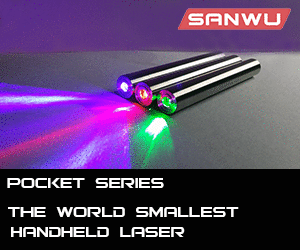Zom-B
0
- Joined
- Mar 25, 2008
- Messages
- 895
- Points
- 28
This is the SXD Green Laser Pointer, sold by DealExtreme for $16,99. (SXD is the brand name)

Compared to a regular bullet pointer it is not much larger. It's very heavy, feels very solid and the parts align very precisely, which is very rare for a cheap laser pointer. It has no coating so the only wear it will undergo are fine scratches.
When turning it on, I noticed it has a slow on. It takes toughly 0.5 to 1 seconds to reach full power (depending on the batteries, full=0.5). During this time, a mode hop is clearly visible. At full power it runs TEM00.
Mode hop during power-on:

The beam diameter is very tight, oval, 1.2mm x 1.6mm. Divergence is 0.9 mRad. The beam exits off-center, almost at the edge. I reckon this has to do with occluding the secondary TEM01 beam.
The batteries are drained very quickly. At 4.5V it consumes about 195mA and it raises steadily with temperature, indicating the driver uses optical feedback. After 60 seconds it's at 230mA and still rising. Long runs are not recommended for the sake of the battery life.
After having it on for like 5 minutes with a duty cycle of 15 seconds on, a drop in power is clearly visible. After using it for like 20 minutes, the spot almost falls below lasing threshold. When leaving the laser off for an hour or so restores some of the intensity, but after a few clicks it's dim again. When it's dim it operates on TEM01.
The next three photos compare it to my DX50 with different battery charges.
New batteries:

After 5 minutes (not continuously):

After 20 minutes (not continuously):

The lens is easily removed, as it's hold into place with silicon glue. When removed, the secondary TEM01 beam can escape through the aperture. This way TEM01 mode is clearly visible. In the photo above, with the floppy, the marked distortion is actually the reflection of a tiny part of the secondary beam that reflects off of the insideside of the lens barrel.

Sometimes when looking at the aperture, a faint reflection of dark red is visible on the inside of the aperture, this was my first indication that there is no IR filter. Hell, I did not even know dark red was a spectral color, but it actually looks dark red, not just red with less intensity. Maybe this has to do with the impact difference it has on the red cones and rods in the eye.
I used an IR filter (one that passes ONLY IR), to see for sure.


Ok, that's clearly a lot of IR, and my camera even has an IR filter itself.
While experimenting, it struck my attention that my DX50 also emits some IR, despite an IR filter. Actually, according to my camera, they both put out equal amounts of IR.
DX50:

mini10:


Compared to a regular bullet pointer it is not much larger. It's very heavy, feels very solid and the parts align very precisely, which is very rare for a cheap laser pointer. It has no coating so the only wear it will undergo are fine scratches.
When turning it on, I noticed it has a slow on. It takes toughly 0.5 to 1 seconds to reach full power (depending on the batteries, full=0.5). During this time, a mode hop is clearly visible. At full power it runs TEM00.
Mode hop during power-on:

The beam diameter is very tight, oval, 1.2mm x 1.6mm. Divergence is 0.9 mRad. The beam exits off-center, almost at the edge. I reckon this has to do with occluding the secondary TEM01 beam.
The batteries are drained very quickly. At 4.5V it consumes about 195mA and it raises steadily with temperature, indicating the driver uses optical feedback. After 60 seconds it's at 230mA and still rising. Long runs are not recommended for the sake of the battery life.
After having it on for like 5 minutes with a duty cycle of 15 seconds on, a drop in power is clearly visible. After using it for like 20 minutes, the spot almost falls below lasing threshold. When leaving the laser off for an hour or so restores some of the intensity, but after a few clicks it's dim again. When it's dim it operates on TEM01.
The next three photos compare it to my DX50 with different battery charges.
New batteries:

After 5 minutes (not continuously):

After 20 minutes (not continuously):

The lens is easily removed, as it's hold into place with silicon glue. When removed, the secondary TEM01 beam can escape through the aperture. This way TEM01 mode is clearly visible. In the photo above, with the floppy, the marked distortion is actually the reflection of a tiny part of the secondary beam that reflects off of the insideside of the lens barrel.

Sometimes when looking at the aperture, a faint reflection of dark red is visible on the inside of the aperture, this was my first indication that there is no IR filter. Hell, I did not even know dark red was a spectral color, but it actually looks dark red, not just red with less intensity. Maybe this has to do with the impact difference it has on the red cones and rods in the eye.
I used an IR filter (one that passes ONLY IR), to see for sure.


Ok, that's clearly a lot of IR, and my camera even has an IR filter itself.
While experimenting, it struck my attention that my DX50 also emits some IR, despite an IR filter. Actually, according to my camera, they both put out equal amounts of IR.
DX50:

mini10:




